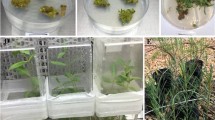Abstract
A long-term suspension culture ofBrachycome dichromosomatica (2n = 4) was induced from a cotyledon-derived callus. Subcultures were obtained every week up to three years. The bulk of the cultures displayed a stable diploid karyotype, while one cell line evolved with 2n = 5 chromosomes in the 86th reinoculation. No further chromosomal change occurred also in that cell line. It is assumed that the fifth chromosome is the expression of a trisomy 2.
The chromatin ultrastructure was of the species-specific chromomeric type in the wild-type line, while the trisomic line displayed more condensed chromatin, what probably indicates a rather inactive state of the extra-chromosome.Brachycome dichromosomatica is suggested to represent an ideal species to follow-up karyotype stability and/or variation in cell culture.
Similar content being viewed by others
References
Bajaj, Y. P. S., (Ed.) 1985a: Biotechnology in Agriculture and Forestry, Vol. 1, Trees I. — Berlin, Heidelberg, New York: Springer.
—, 1985b: Ibidem, Vol. 2, Crops I. — Berlin, Heidelberg, New York: Springer.
Bayliss, M. W., 1980: Chromosomal variation in plant tissues in culture. — Int. Rev. Cytol., Suppl.11 A, 113–139.
Carter, C. R., 1978a: Taxonomy of theBrachycome lineariloba complex (Asteraceae). — Telopea1, 387–393.
—, 1978b: The cytology ofBrachycome. 8. The inheritance, frequency and distribution of B chromosomes inBrachycome dichromosomatica (2n = 2), formerly included inB. lineariloba. — Chromosoma67, 109–121.
D'Amato, F., 1975: The problem of genetic stability in plant tissue and cell cultures. — InFrankel, O., Hawkes, J. G., (Eds.): Crop Resources for Today and Tomorrow, pp. 333–348. — Cambridge: University Press.
—, 1986: Cytogenetics of plant cell and tissue cultures and their regenerates. — CRC Crit. Rev. Plant Sci.3, 73–112.
Dixon, R. A., 1985: Plant Cell Culture. — Oxford (WA, U.S.A.): IRL Press.
Flick, C. E., Evans, D. A., 1983: Genetic variation derived from plant cell cultures. — Curr. Top. Pl. Biochem. Physiol.2, 200–210.
Gamborg, O. L., Miller, R. A., Ojima, K., 1968: Nutrient requirements of suspension cultures of soybean root cells. — Exp. Cell Res.50, 151–158.
Gould, A. R., 1978: Diverse pathways of morphogenesis in tissue cultures of the compositeBrachycome lineariloba (2n = 4). — Protoplasma97, 125–135.
—, 1979: Chromosomal and phenotypic stability during regeneration of whole plants from tissue cultures ofBrachycome dichromosomatica (2n = 4). — Austral. J. Bot.27, 117–121.
Kao, K. N., 1982: Staining methods for protoplasts and cells. — InWetter, L. R., Constabel, F., (Eds.): Plant Tissue Culture Methods, pp. 67–71. — Saskatoon, Canada: Natl. Res. Council.
Marks, G. E., 1973: A rapid HCl/toluidine blue squash technique for plant chromosomes. — Stain Technol.48, 229–231.
Mello, M. L. S., 1980: Toluidine blue binding capacity of heterochromatin and euchromatin ofTriatoma infestans Klug. — Histochemistry69, 181–187.
Murashige, T., Skoog, F., 1962: A revised medium for rapid growth and bioassays with tobacco tissue cultures. — Physiol. Plant.15, 473–497.
Nagl, W., 1982: Nuclear chromatin. — InParthier, B., Boulter, D., (Eds.): Encyclopedia of Plant Physiology, New Ser., Vol.14B, pp. 1–45. — Berlin, Heidelberg, New York: Springer.
—, 1984: Species and hybrid diagnosis in plants by means of quantitative light and electron microscopic morphometry of chromatin texture. — Microsc. Acta, Suppl.4, 19–25.
Nagl, W., Ribicki, R., Mertler, H.-O., Hezel, U., Jacobi, R., Bachmann, E., 1984: The fluorophenylalanine sensitive and resistant tobacco cell lines, TX 1 and TX 4. 1. DNA contents, chromosome numbers, nuclear ultrastructures and effects of spermidine. — Protoplasma122, 138–144.
Orton, T. J., 1983: Experimental approaches to the study of somaclonal variation. — Pl. Mol. Biol. Rep.1, 67–76.
Papeš, D., Garaj-Vrhovać, V., Jelaska, S., Kolevska-Pletikapić, B., 1983: Chromosome behaviour in cultured cell populations of higher plants. — InBrandham, P. E., Bennett, M. D., (Eds.): Kew Chromosome Conference II., pp. 155–163. — London: George Allen & Unwin.
Reinert, J., Bajaj, Y. R. S., (Eds.), 1977: Applied and Fundamental Aspects of Plant Cell, Tissue and Organ Culture. — Berlin, Heidelberg, New York: Springer.
Reinert, J., Yeoman, M. M., 1982: Plant Cell and Tissue Culture. A Laboratory Manual. — Berlin, Heidelberg, New York: Springer.
Smith-White, S., 1968:Brachycome lineariloba: a species for experimental cytogenetics. — Chromosoma23, 359–364.
Tschermak-Woess, E., 1963: Strukturtypen der Ruhekerne von Pflanzen und Tieren. — ProtoplasmatologiaVI/1. — Wien, New York: Springer.
Vasil, I. K., (Ed.), 1984: Cell Culture and Somatic Cell Genetics of Plants. — Orlando, FL, U.S.A.: Academic Press.
Watanabe, K., Carter, C. R., Smith-White, S., 1975: The cytology ofBrachycome lineariloba. 5. Chromosome relationships and phylogeny of the race A cytodemes (2n = 2). — Chromosoma52, 383–397.
Author information
Authors and Affiliations
Additional information
As a former student W. N. dedicates this paper in gratitude and admiration to Prof. DrElisabeth Tschermak-Woess on the occasion of her 70th birthday. Prof.Woess with her scientific work has stimulated in an unique manner the study of nuclear structures in plants, of endopolyploidy and polytene chromosomes, and has thus established the basis for the rapidly increasing research in these fields.
Rights and permissions
About this article
Cite this article
Nagl, W., Pfeifer, M. Karyological stability and microevolution of a cell suspension culture ofBrachycome dichromosomatica (Asteraceae). Pl Syst Evol 158, 133–139 (1988). https://doi.org/10.1007/BF00936339
Received:
Issue Date:
DOI: https://doi.org/10.1007/BF00936339




